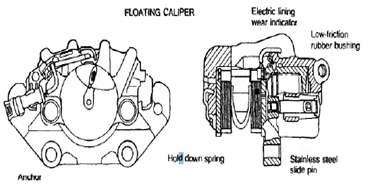←
Automobile Engineering
Floating Caliper Brake
Introduction:
It is a type of the caliper brakes. Caliper brakes are of two types, fixed caliper and floating caliper. Floating caliper brakes offer a number of advantages over fixed caliper designs.
Advantages of floating caliper brake over fixed caliper brakes:
- They are easier to package in the wheel since they do not have a piston on the outboard or wheel side.
- They have a lower brake fluid operating temperature than the fixed caliper and, hence, lower brake fluid vaporization potential.
- They also have fewer leak points, and are easier to bleed in service.
Working of floating caliper brakes:
- A typical floating caliper disc brake is shown in Figure.
- One or two pistons are used on the inboard side only.
- The hydraulic pressure forcing the piston and pad toward the rotor also forces the piston housing (wheel cylinder) in the opposite direction to apply the outboard pad against the rotor.

Disadvantages of caliper brakes:
- A major disadvantage of floating caliper disc brakes is the potential for pad dragging due to insufficient pad return since one piston seal must provide the clearance for both the pads.
- There is also an increased potential for squeal due to a larger number of degrees of freedom when compared with the fixed caliper designs and on some earlier designs reduced effectiveness due to corrosion of sliding surfaces.
- Modern calipers all have sealed-Lubricated sliding pins as guiding members.
The problems mentioned tend to be more pronounced for floating caliper disc brakes with wheel cylinder size greater than 2 to 2.25inches in diameter.